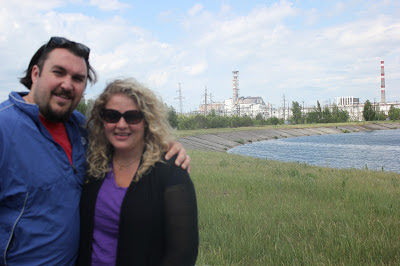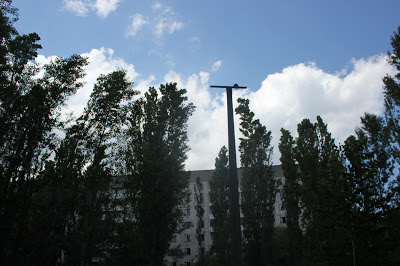After spending our first day in Kiev exploring the city we spent the next day doing something a bit more unusual. We went on an all day tour to Chernobyl, the site of the horrific nuclear disaster nearly 30 years ago. From the moment we knew we were headed to the Ukraine, Tom was convinced that we had to take the opportunity to see Chernobyl. I wasn't as sold on the idea and needed some time to do my research before feeling comfortable going -- it is a site that still emits low levels of radiation and the Ukrainian government only allows you to visit for a maximum of four hours a day.
For those that need a refresher....from Wikipedia
The Chernobyl disaster (Ukrainian: Чорнобильська катастрофа, Chornobylska Katastrofa – Chornobyl Catastrophe) was a catastrophic nuclear accident that occurred on 26 April 1986 at the Chernobyl Nuclear Power Plant in Ukraine (then officially the Ukrainian SSR), which was under the direct jurisdiction of the central authorities of the Soviet Union. An explosion and fire released large quantities of radioactive particles into the atmosphere, which spread over much of the western USSR and Europe.
The Chernobyl disaster is widely considered to have been the worst nuclear power plant accident in history, and is one of only two classified as a level 7 event on theInternational Nuclear Event Scale (the other being the Fukushima Daiichi nuclear disaster in 2011).[1] The battle to contain the contamination and avert a greater catastrophe ultimately involved over 500,000 workers and cost an estimated 18 billion rubles.[2] The official Soviet casualty count of 31 deaths has been disputed, and long-term effects such as cancers and deformities are still being accounted for.
We got up bright and early to meet our tour bus for the close to two hour ride North to the Ukrainian/Russian border. During the ride we watched a documentary all about the tragic event and also learned about the ruled while visiting...most importantly - Not touching any live plants, trees or grass as these have much higher radiation levels than concrete. Our tour guide even carried a geiger counter with him the entire time to monitor the radioactivity levels during our tour. After passing through a government control point we made our way into the area. Our first stop was at an abandoned kindergarten and primary school. It was absolutely unbelievable and surreal to see how everything in the school had literally been left and remained in its place while the trees and grass continued to grow around it. After the reactor exploded the entire city was forced to leave about 12 hours later. They had no idea that they would never be returning to their homes, therefore they took very little of their personal belongings with them. After the kindergarten we stopped at a number of memorials honoring that various fire and police personnel that were first responders on the site and helped to save the lives of thousands of people by reacting quickly and risking their own lives in the process.
Next, we finally made it to the actual site of the reactors. It doesn't look like much more than a series of factories and its really hard to imagine one of the reactors exploding and causing so much harm. There is a concrete casing over the exploded reactor to prevent it from leaking further, but unfortunately that solution was only temporary for about 30 years. So, next to the reactors there are workers who are in the process of constructing a new cover for the reactor that will be slid into place next year. Even now, almost 30 years later the construction workers are forced to work in highly regulated shifts in order to limit their radiation exposure.
The most interesting part of the tour was visiting Pripyat. This was a city of nearly 50,000 people all of whom lived in this area to be close to their jobs near the Chernobyl plant. This city had to be quickly evacuated after the accident and these people had no idea they would never be returning home. All of the buildings of this town still exist as concrete shells that have been overtaken by the trees and grass in the area. Its crazy to walk through such a quiet and serene place and to imagine the place full of life and happiness just years ago.
All in all it was an incredibly interesting experience to see the remanence of a former civilization that was abandoned so recently -- A sobering reminder of a horrific accident.
.JPG) |
| At the government checkpoint before entering the area |
 |
| A memorial to the children of Chernobyl |
 |
| Official Chernobyl Entrance |
 |
| A memorial to the first responders |
 |
| The entrance to the abandoned kindergarten |
 |
| Inside the kindergarten |
 |
| Everything was left |
 |
| On the pathway leading up to the kindergaten |
 |
| The Chernobyl Power Plant Site |
 |
| The reactors in the distance |
 |
| Is that a Xmas card photo or what? The Sullivan's in front of the Chernobyl Reactors |
 |
| The exploded reactor in its current casing |
 |
| The shell that is under construction to cover the reactor |
 |
| Tom loved learning all about this site! |
 |
| The entrance to the town of Pripyat |
 |
| Abandoned apartment buildings |
 |
| Abandoned shoppingcenter |
 |
| An abandoned hotel |
 |
| Tom and his graffiti shadow |
 |
| Amazing natural beauty among the vacant buildings |
 |
| Communist propaganda posters left inside a building since there was a big rally scheduled for days after the explosion |
.JPG) |
| An abandoned amusement park that was scheduled to open a month after the accident |
 |
| Abandoned bumper cars |
 |
| The former soccer stadium in Pripyat |
 |
| Typical Ukrainian lunch after our tour |
 |
| Yes, we were required to go through radiation detectors before leaving - Thank goodness we passed! |
.JPG) |
| All in all a super cool experience! |
.JPG)




















.JPG)




.JPG)
































No comments:
Post a Comment